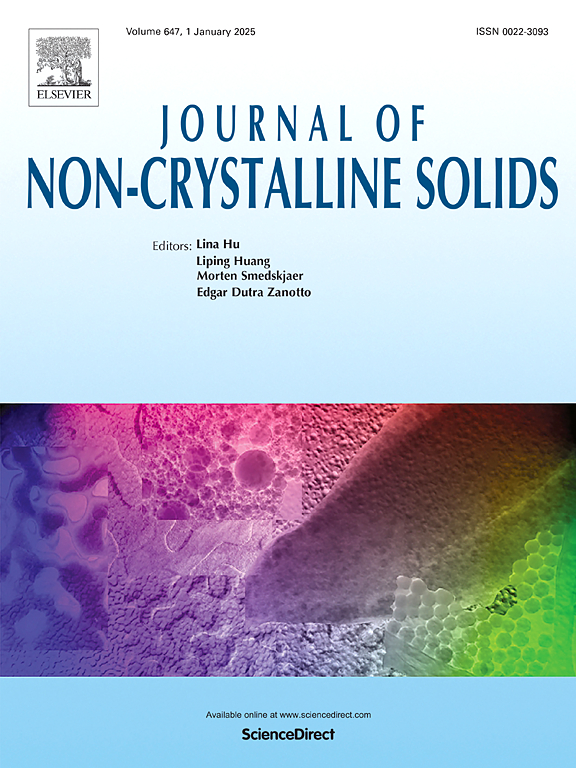Effect of Nb on thermal stability of Ni-Co-W-B metallic glasses: A kinetic study
IF 3.2
3区 材料科学
Q1 MATERIALS SCIENCE, CERAMICS
引用次数: 0
Abstract
In this study, the effect of Nb addition on the continuous heating diagram of the Ni-Co-W-B metallic glass alloy system was investigated, and the improvement in glass-forming ability and thermal stability was demonstrated. Based on differential scanning calorimetry (DSC) analyses performed under non-isothermal conditions, a theoretical continuous heating diagram was constructed using the well-known Kissinger kinetic equation. Furthermore, the boundary line of the transition from the amorphous to the crystalline phase was validated through isothermal heat treatments. The findings indicate that modifying the refractory element content by incorporating 6 at. % Nb into the alloy composition improves thermal stability at higher temperatures. The XRD results also demonstrate that the addition of Nb enhances the alloy's glass-forming ability threefold and increases the critical casting thickness from 0.5 mm to 1.5 mm. The local activation energy values calculated for different crystallization fractions indicate that the activation energies required for any given crystallization fraction in the Ni32.75Co22.55W23.7B15Nb6 alloy are higher than those in Ni35.116Co24.184W23.7B17 the alloy. Furthermore, the primary crystallization phase boundary line in the continuous heating transformation diagram shifts to both higher temperatures and longer times. These results highlight the role of Nb addition in retarding the crystallization in the Ni-Co-W-B alloy system.
Nb对Ni-Co-W-B金属玻璃热稳定性影响的动力学研究
本研究考察了Nb的加入对Ni-Co-W-B金属玻璃合金体系连续升温图的影响,证明了Nb对玻璃形成能力和热稳定性的改善。基于非等温条件下的差示扫描量热(DSC)分析,利用Kissinger动力学方程构建了理论连续升温图。此外,通过等温热处理验证了非晶态向晶态转变的边界线。结果表明,掺入6at可以改变耐火元素的含量。在合金成分中加入% Nb提高了高温下的热稳定性。XRD结果还表明,Nb的加入使合金的非晶形成能力提高了3倍,临界铸造厚度从0.5 mm提高到1.5 mm。不同晶化组分的局部活化能计算结果表明,Ni32.75Co22.55W23.7B15Nb6合金中任一晶化组分所需的活化能均高于ni35.116 co24.185 w23.7 b17合金。在连续加热转变图中,初生结晶相边界线向更高的温度和更长的时间移动。这些结果突出了Nb在Ni-Co-W-B合金体系中延缓结晶的作用。
本文章由计算机程序翻译,如有差异,请以英文原文为准。
求助全文
约1分钟内获得全文
求助全文
来源期刊

Journal of Non-crystalline Solids
工程技术-材料科学:硅酸盐
CiteScore
6.50
自引率
11.40%
发文量
576
审稿时长
35 days
期刊介绍:
The Journal of Non-Crystalline Solids publishes review articles, research papers, and Letters to the Editor on amorphous and glassy materials, including inorganic, organic, polymeric, hybrid and metallic systems. Papers on partially glassy materials, such as glass-ceramics and glass-matrix composites, and papers involving the liquid state are also included in so far as the properties of the liquid are relevant for the formation of the solid.
In all cases the papers must demonstrate both novelty and importance to the field, by way of significant advances in understanding or application of non-crystalline solids; in the case of Letters, a compelling case must also be made for expedited handling.
 求助内容:
求助内容: 应助结果提醒方式:
应助结果提醒方式:


